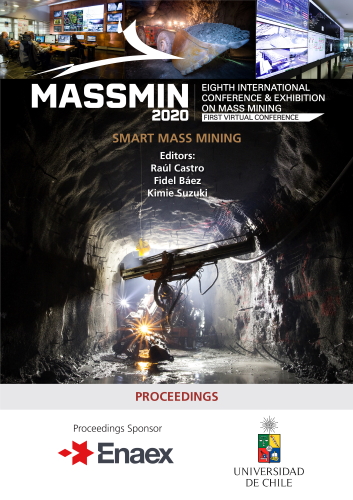High-capacity production systems for Block Caving mines

|
Authors: Morrison, DM; Labrecque, PO |
This paper is hosted with the kind permission of Lulea University of Technology, International Conference & Exhibition on Mass Mining, 2024.
DOI https://doi.org/10.36487/ACG_repo/2063_48
Cite As:
Morrison, DM & Labrecque, PO 2020, 'High-capacity production systems for Block Caving mines', in R Castro, F Báez & K Suzuki (eds), MassMin 2020: Proceedings of the Eighth International Conference & Exhibition on Mass Mining, University of Chile, Santiago, pp. 703-715, https://doi.org/10.36487/ACG_repo/2063_48
Abstract:
As the production targets for block caving mines increase, there has to be an increase in the productive capacity of the operation, without increasing cost of having more active extraction drives. The simulation analysis will show a clear limitation to the productive capacity of a system of mobile LHDs and will also show how easily a continuous extraction system can overcome this limitation. There are several possible alternatives for such a system but there are process constraints that severely limit the number of options. These include the need for continuous access to all active draw-points, the ability to manage variations in ore fragmentation, and the rapid relocation from one draw-point to another, are some of the most important. The system also has to be sufficiently flexible to cope with the kind of seismic damage that often occurs in active extraction drives. A continuous extraction system that produces over 100,000 tonnes per day requires extraction drives to produce close to 5-10,000 tonnes per day each. The capital equipment cost of such a system would be much higher than batch production equipment, but the simulation results show how the increase in productive capacity creates a more cost-effective production process, with lower labour costs and lower energy cost. The simulation results also show the impact of a high-production capacity system on the rate of development of new extraction drives. The results show that long-term future of larger, more productive Block Caving mines will rely on the development and implementation of flexible, continuous extraction systems.
References:
Goldratt, EM & Cox, J 1984, ‘The Goal: Excellence in Manufacturing’ Published by North River Press, Great Barrington, MA, USA.
Morrison, DM 2019, ‘CEMI seeks to accelerate Advance rates.’ Canadian Mining Journal, Feb/March 2020, pp. 48-51.
Morrison, DM 2017, ‘Meeting the Productivity Challenge below 2.5kilometres.’, in M. Hudyma & Y. Potvin (eds.) Proceedings of the First International Conference on Underground Mining Technology, Australian Centre for Geomechanics, Perth, pp. 3-8.
Shelswell, KJ, Labrecque, PO & Morrison, DM 2018, ‘Increasing productive capacity in block caving mines’, in Y Potvin & J Jakubec (eds), Proceedings of the Fourth International Symposium on Block and Sublevel Caving, Australian Centre for Geomechanics, Perth, pp. 107-118.
© Copyright 2026, Australian Centre for Geomechanics (ACG), The University of Western Australia. All rights reserved.
View copyright/legal information
Please direct any queries or error reports to repository-acg@uwa.edu.au
View copyright/legal information
Please direct any queries or error reports to repository-acg@uwa.edu.au
